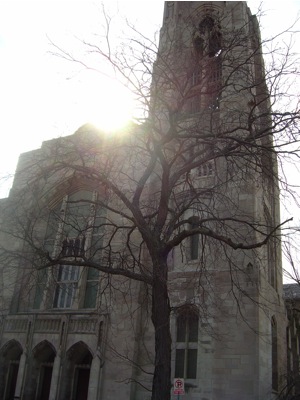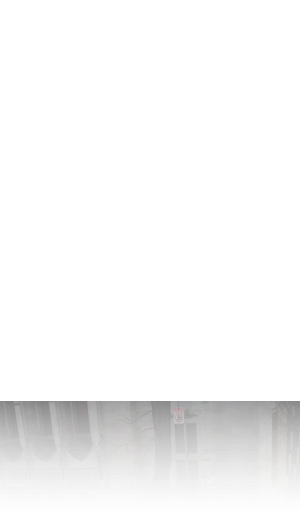Religion in Hyde Park

Walking Tour of Religion in Hyde
Park, Kenwood & Woodlawn
This route, roughly three miles long, will take you to some of the most historically and architecturally significant houses of worship in Hyde Park and displays the area’s remarkable religious diversity.
Start at Masjid al-Fatir (1200 E. 47th), one of the largest and most impressive of the Southside’s growing number of mosques. Its community follows the more traditional version of Islam favored by W. Deen Mohammed, son of the Nation of Islam’s founder Elijah Mohammed.
A half-mile south on University Avenue sits Congregation KAM Isaiah Israel (1100 E. Hyde Park), a community that has existed in various places in Chicago since 1847. Like many long-lived religious communities in Chicago, it has migrated through various parts of town. The building, an official Chicago Landmark reminiscent of ancient Byzantine synagogue designs, has stood since 1924. While its roots are in the Orthodox tradition, KAM Isaiah Israel is now part of the Union for Reform Judaism.
Go south on Woodlawn and turn left (east) on 55th Street and you come to St. Thomas the Apostle Church (5472 S. Kimbark), Hyde Park’s immense Roman Catholic parish. It is home to both a church and a school. The sheer brick exteriors and vaguely Spanish decorative work make this church, finished in 1923, a distinctive local landmark. Like the other churches of Hyde Park, St. Thomas the Apostle partakes of the neighborhood’s diverse and international spirit.
Back on Woodlawn Avenue, Augustana Lutheran Church (1100 E. 55th) is one of the last vestiges of a once-large Swedish immigrant population in Hyde Park. Founded in 1903, its original building burned in 1963. The current building, a modernist structure with a stark and ancient-feeling sanctuary, was completed in 1968. Today a vibrant congregation composed of Lutherans from Europe, Asia, and Africa as well as from the United States worships at Augustana.
Hyde Park Union Church (5600 S. Woodlawn), just south of Augustana, was founded in 1874 and brought to prominence by many of the same people who founded the University of Chicago. Today it is a joint congregation of the American Baptist Churches and the United Church of Christ, inheritors of the progressive Protestant tradition that characterized both the church’s and the University’s founding. Architecturally impressive both inside and out, this church is home to a racially and economically diverse congregation.
Rockefeller Memorial Chapel (5850 S. Woodlawn) is, despite the modest-sounding title ‘chapel,’ one of the city’s largest and most impressive Protestant houses of worship. It has played host to many of the 20th century’s greatest preachers, and since the opening of an interfaith center last year, has become the de facto center of organized religious life on campus. The chapel was completed in 1928 after ten years of construction (and the death, in 1924, of its architect) and is a classic of the high Protestant style of the era’s churches. The chapel serves both religious and secular functions, from Sunday worship to musical and dramatic performances to convocations to a 2003 anti-war rally.
Heading south across the Midway from Rockefeller, it’s not hard to miss First Mount Calvary Missionary Baptist Church (6111 S. Kenwood), a small, traditional structure at the northern end of the rapidly changing Woodlawn neighborhood. This small and friendly church bears witness to the African-American Christian heritage in its worship and preaching.
A few blocks south, the Apostolic Church of God (6320 S. Dorchester) is as huge and modern as First Mount Calvary is modest and traditional. Rev. Arthur Brazier became the pastor of this small Pentecostal congregation over 40 years ago, as Woodlawn’s African American population was growing and its white population falling. Rev. Brazier became a prominent figure in neighborhood and city politics as the president of The Woodlawn Organization and an associate of Martin Luther King, Jr. during his time in Chicago. Today the church features a 3,000-seat sanctuary and is home to varied ministries and cultural events.
One block south and two short blocks west, First Presbyterian Church (6400 S. Kimbark) is one of the oldest remaining Protestant churches on the south lakefront. Unlike most of the other white churches in Woodlawn, First Presbyterian did not close down or move to the suburbs during white flight, but rather stayed to minister to the changing community. The church was caught in controversy in the middle 1960’s as it tried to mediate between the wider community and the Blackstone Rangers street gang. Its activist past lives on in the church today.
Directly west of First Presbyterian stands the old St. Gelasius Church (6415 S. Woodlawn), a defunct parish edifice, now home to the Institute of Christ the King Sovereign Priest. The church was built in 1927 in a Renaissance Revival style and was threatened with demolition after its 2002 closure. The religious order that currently tenants the building celebrates Mass and other rituals in the medieval Latin style.
Hyde Park Theological Schools
An important part of Hyde Park’s history is its role as a center of theological and seminary education. These historic and architecturally impressive schools can be seen as part of a single afternoon’s walking tour.
The Catholic Theological Union (5401 S. Cornell) is a young institution, founded in 1968 by three Roman Catholic religious orders. Today over 30 orders are part of CTU, and the Union ordains a large percentage of all religious order priests in the U.S. A large new building in a contemporary style was opened in 2006, across the street from the original building.
A merger of six different Lutheran seminaries, the Lutheran School of Theology in Chicago (1100 E. 55th) opened its doors in 1967. The imposing modern building is home to degree programs in ministry and theology. The school shares library resources with McCormick Theological Seminary (5460 S. University). This airier and more recent structure is linked with the Lutheran School by two second-story walkways. The school trains pastors and theologians for the Presbyterian Church.
The Chicago Theological Seminary (5757 S. University), open since 1855, primarily educates ministers for the United Church of Christ. Its soaring towers and Gothic revival style persuade many at first glance that it is part of the University of Chicago campus, though it is in fact a considerably older institution. The seminary is home to the famous Seminary Co-op Bookstore, where University and Seminary students buy many of their books. The lovely second-floor chapel hosts free noontime organ recitals on Fridays throughout the academic year.
Swift Hall is home to the University of Chicago Divinity School (1058 E. 58th). The hall’s central location bears witness to the University’s founding ideal of an intellectual culture energized by the academic study of religion. Many great scholars of religion have called the Divinity School home, some of whom took themselves and their clergy collars south to march for voting rights with the Rev. Dr. Martin Luther King, Jr. Some of the cheapest and best food on campus can be found in the basement coffee shop.
Meadville-Lombard Theological School (5701 S. Woodlawn) came out of the merger of Meadville Theological School and Lombard Universalist Divinity School in 1929. The school specializes in the study of liberal religion and specifically the Unitarian-Universalist heritage.


uchicago®  ©2007 The University of Chicago®
©2007 The University of Chicago®  5801 South Ellis Ave., Chicago, IL 60637
5801 South Ellis Ave., Chicago, IL 60637  773-702-1234
773-702-1234
 ©2007 The University of Chicago®
©2007 The University of Chicago®  5801 South Ellis Ave., Chicago, IL 60637
5801 South Ellis Ave., Chicago, IL 60637  773-702-1234
773-702-1234